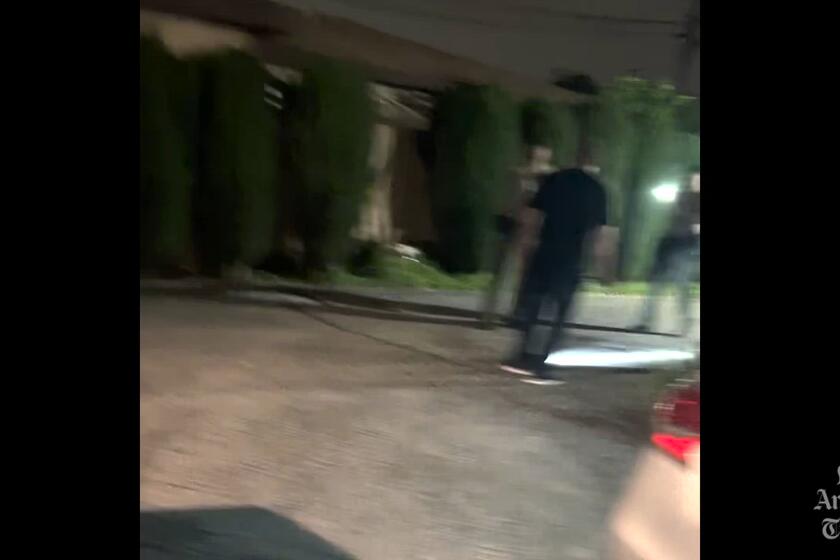Program Aims to Keep Pupils Out of Gangs
Fifth-grader Maria Espinoza knows what belonging to a gang can mean--death.
“I want to give you a message,” Maria said. “Stay away from gangs. You should not even have gang members as your friends. My cousin was killed at a party because he played with gangs.”
For the record:
12:00 a.m. March 1, 1987 For the Record
Los Angeles Times Sunday March 1, 1987 Home Edition South Bay Part 9 Page 2 Column 6 Zones Desk 3 inches; 96 words Type of Material: Correction
A United Way-sponsored anti-gang program at Wilmington Park Elementary School is known as the Gang Alternatives Program. A Feb. 19 story in The Times called it by a different name. The story also misstated the amount United Way has spent on the program. Although the agency has set aside $480,000 to expand the program to several schools, only $98,000 has been spent at Wilmington Park. The story also said that a survey of children completing the program found that 95% of them were not interested in joining gangs. Those results actually came from a survey conducted after another gang program at a different school, although a United Way survey found similar results at Wilmington Park.
She was giving her testimony to more than 200 of her classmates, their parents and friends at Wilmington Park Elementary School last week as they became the first graduates of the school’s Gang Awareness Program.
Fred Guajaca sat in the audience and wondered if the program might have made a difference for him when he attended Wilmington Park 30 years ago. Guajaca knew Maria was telling the truth. He lived it.
“It was a hard-core experience,” recalled Guajaca, who said he was a gang member from the time he was in junior high school until he was 30. “I was too far gone. I was into shootings, drugs, alcohol, the whole thing. Half of my friends were either shot or in the penitentiary.”
The gang awareness class “would have been something to think about,” Guajaca said as he watched his nephew get a completion certificate.
The program, sponsored by the United Way, various local businesses and individuals, is a $480,000 effort to recruit Harbor-area children to a life without gangs, before they reach the age when gangs begin to exert pressure on their lives.
Eight schools in Wilmington, San Pedro and Harbor City are in the program area. Hawaiian Avenue, Barton Hill and Gulf Avenue, in addition to Wilmington Park, completed the program during the first semester. Broad Avenue, Fries Avenue, Normont and Bandini Street are in their second week of classes. The students participate in weekly 45-minute sessions, where they see slide shows and graphics and discuss the dangers of gang membership.
95% Reject Gangs
In a survey, 95% of the children who completed the program said they wanted no part of gangs, compared to the 50% who gave that answer before they began the program.
But Wilmington Park Principal Claire Sizgorich said the program’s effectiveness will not be known until the students reach the seventh grade.
“It’s hard to measure now, because there is no gang activity here” at the school, Sizgorich said. “My oldest children are only in the sixth grade. It’s when they get to junior high that the real introduction to gang activity begins. (Gangs) aren’t interested in the babies.”
If the gangs aren’t interested in the “babies,” the “babies” do sometimes attempt to mimic the gangs, Sizgorich said. She said she believes that that kind of activity slowed after the program began.
Teachers More Aware
“They aren’t marking their hands with fake tattoos and you don’t hear them talking about the gangs as much anymore,” Sizgorich said. “Because of the training, the teachers are more aware of gang symbols also.”
The plan calls for a follow-up program in two years, when the youngsters are in junior high, to reinforce the lessons they have learned.
“Before the GAP Program, I did not know much about gangs, drugs or other bad things,” graduate Daniel Garcia told the group. “I was taught that gangs are bad for me and that drugs can make you very sick. When you join a gang the members will ‘jump you in.’ That means they will beat you up.”
Guajaca said that he joined a gang because it was expected of him. He sees the program as a way to help kids see that there is more to life than “the neighborhood.”
‘Just Grow Into Them’
“(Gang membership) is a pattern, a tradition. It’s part of machoism,” said Guajaca, whose forearm still bears a gang’s tattoo despite efforts to remove it. “If you are not aware of gangs you’ll just grow into them.”
Maria Figueroa, the program coordinator, said the children are exposed to gang violence as part of their daily lives.
“Some of the children have relatives that were in gangs, who have gone to prison and when they get out they are again in gangs,” Figueroa said. “The problem is here. I hear the children’s stories every day--how they know somebody who wore a black jacket in the wrong neighborhood so someone shot them in the eye. But this is something all of the children need to know.”
The Los Angeles Police Department’s Harbor Division ranks fourth of the city’s 18 divisions in gang violence. The department says that there are more than 1,800 gang members in the area. In 1986 there were 530 gang-related violent crimes in the Harbor Division, up from 402 in 1985.
Convinced of Success
Figueroa, 28, who says she “never was in a gang and never will be,” said she is convinced that the children believe what they have been taught in the class and are not just giving her the answer they know she wants to hear.
“I don’t make their decisions for them, but I give them the power of decision so that they can decide for themselves,” Figueroa said. “I won’t be there with them when they get to junior high.”
Figueroa said she uses a game to illustrate to the students the constraints that she says are imposed on gang members.
“I divide them up into three groups--the Hot Dogs, the Corn Dogs and Freedom,” Figueroa said. “We tell them that if they’re a Hot Dog they have to stay in this part of the room, if they’re a Corn Dog they have to stay in another. But if they’re Freedom, they can go anywhere. This shows them the limitations of territory that a gang imposes on them.”
Funding a Problem
One obstacle that the program has yet to overcome is its funding for next year. The United Way hasn’t decided whether to continue its $98,000 portion of the budget and other groups are awaiting its lead. The Los Angeles Unified School District has not committed its support yet either, but Figueroa said school board member John Greenwood has assured her that the district will continue its support.
Sizgorich hopes her school won’t have to give up the program.
“I want to thank whatever God is responsible for this,” Sizgorich said. “My children need it.”
More to Read
Start your day right
Sign up for Essential California for news, features and recommendations from the L.A. Times and beyond in your inbox six days a week.
You may occasionally receive promotional content from the Los Angeles Times.






